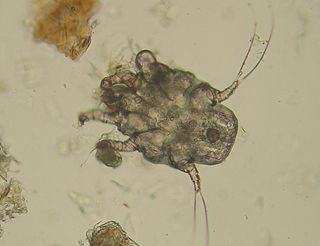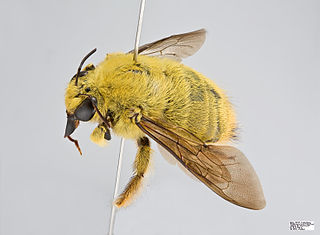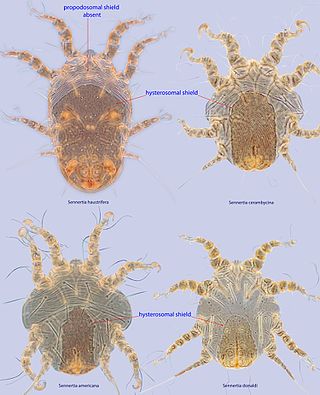
An acarinarium is a specialized anatomical structure which is evolved to facilitate the retention of mites on the body of an organism, typically a bee or a wasp. The term was introduced by Walter Karl Johann Roepke.

Tarsonemus is a genus of trombidiform mites within the family Tarsonemidae.

The Acaridae are a family of mites in order Sarcoptiformes.

Tydeus is a genus of mites belonging to the family Tydeidae. These are small, usually white, mites with soft bodies covered in striations and each leg terminating in two claws.

Astigmatina is a clade of mites in the superorder Acariformes. Astigmata has been ranked as an order or suborder in the past, but was lowered to the unranked clade Astigmatina of the clade Desmonomatides in the order Sarcoptiformes. Astigmatina is now made up of the two groups Acaridia and Psoroptidia, which have been suborders of the order Astigmata in the past. Astigmatina contains about 10 superfamilies and 76 families under Acaridia and Psoroptidia.
The Raphignathoidea is a superfamily of the Acari (mite) order Trombidiformes, comprising 1087 species in 62 genera and 12 families.

Histiostoma is a genus of mites in the family Histiostomatidae.

Dermanyssoidea is a superfamily of mites, including most of the mites which parasitise vertebrates.
Cosmoglyphus is a genus of mites in the family Acaridae.

Rhizoglyphus is a genus of mites in the family Acaridae. It has a worldwide distribution and is often associated with the bulbs, corms or tubers of plants.
Schwiebea is a genus of mites in the family Acaridae. It is among the largest in the family with over 60 species.
The family Ameroseiidae is one of the three families of mites under the superfamily Ascoidea. There are about 12 genera and more than 130 described species in Ameroseiidae. The family has a worldwide distribution.
Antennoseius is a genus of mites in the family Ascidae. As of 2021, it comprised 59 species mostly in subgenera Antennoseius and Vitzthumia, as well as six species not assigned to a subgenus.

Parasitellus is a genus of mites in the family Parasitidae which are obligatory parasites of bumblebees. These mites can be found clinging to the carapace, sometimes in large numbers. Mites in this genus hibernate in the deutonymphal stage. In the tritonymph stage they can actively transfer from bumblebee to bumblebee from flowers, where they can survive up to 24 hours. After they arrive in a bumblebee nest, they will moult into adults. Whilst it is not known what factors trigger the mite to molt, in laboratory conditions P. fucorum were found to moult after eating fresh pollen, although overall moulting success was low. They are kleptoparasitic or neutral to beneficial, depending on life stage; females and deutonymphs feed on provisioned pollen, while other stages are predators of small arthropods.

Phoresis or phoresy is a non-permanent, commensalistic interaction in which one organism attaches itself to another solely for the purpose of travel. Phoresis has been observed directly in ticks and mites since the 18th century, and indirectly in fossils 320 million years old. It is not restricted to arthropods or animals; plants with seeds that disperse by attaching themselves to animals are also considered to be phoretic.

Xylocopa caffra is a species of Afrotropical carpenter bee that ranges from west to central and southern Africa, besides Madagascar and some Indian Ocean archipelagos.
Chaetodactylus is a genus of parasitic mite primarily associated with solitary bees with over 20 species.

Sennertia is a genus of mites in the Chaetodactylidae family. There are more than 70 species. Some of these mites are parasites or commensals of bees, but the presence in some bees of specialized structures for carrying mites (acarinarium) indicates the mutualistic nature of the relationship of some species. Most species of the genus Sennertia settle on adult bees as heteromorphic deutonymphs, but the species Sennertia vaga has no deutonymph and settle on adult bees in the eating adult stages. Reproduction and feeding occurs during resettlement. Most species occur on small carpenter bees (Ceratina) and large carpenter bees (Xylocopa) of the family Apidae. A few species are associated with Centris (Paracentris) in the Neotropics.

Chaetodactylus krombeini,, was described by Karl Krombein and E. W. Baker in the 1960s. The mites are about 0.5 mm across, with the females larger than the males. Pollen mites are a kleptoparasitic pest of Megachilid solitary bees, with Ch. krombeini found with Osmia lignaria of North America,. Pollen mites do not feed on bees, but rather their provisions, and are harmful because they consume the food resources and starve or stunt the developing larvae; there is evidence that pollen mites also directly harm the egg by puncturing it.
Melicharidae is a family of mites in the order Mesostigmata.













